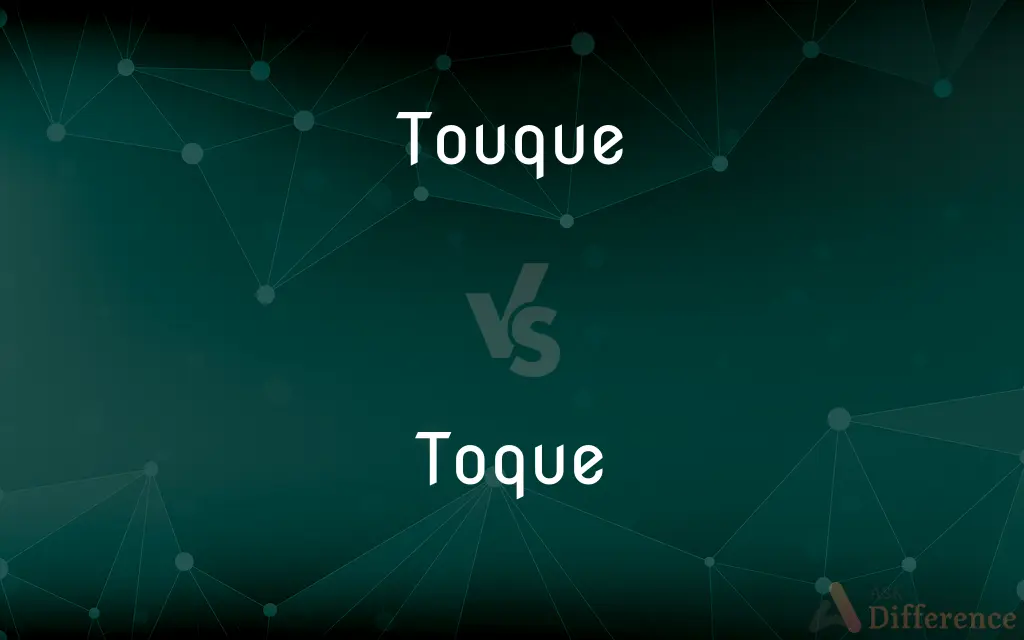Touque vs. Toque — What's the Difference?
By Tayyaba Rehman & Maham Liaqat — Updated on April 1, 2024
Touque is a common misspelling of toque, a knitted hat worn in winter, whereas toque refers to a brimless and close-fitting hat for both men and women.

Difference Between Touque and Toque
Table of Contents
ADVERTISEMENT
Key Differences
Toque, correctly spelled, is a term widely used in Canada and some parts of the United States to describe a knitted hat, often worn in cold weather to keep the head warm. It's a key accessory in winter fashion and functionality. On the other hand, touque is less about a distinct type of headwear and more a common misspelling or variation in the spelling of toque. This discrepancy highlights the importance of regional spelling preferences and the evolution of language in the fashion context.
The history of the toque dates back centuries, with its origins rooted in the fashion of the 13th century, where it was a brimless hat made of fabric or felt. This contrasts with the modern interpretation, which is typically knitted. Whereas touque does not have a separate historical significance or meaning, as it is generally considered an alternate (and less correct) spelling of the same word.
In terms of variety and style, toques can range from simple, solid colors to complex patterns knitted into the fabric. They might also feature embellishments like pom-poms. The term touque, while mainly referring to the same item, may lead to confusion or incorrect usage in written communication about fashion, underscoring the necessity of standardized spelling in the industry.
Culturally, the toque is an emblem of Canadian identity, often associated with the country's love for winter sports and outdoor activities. It symbolizes warmth, comfort, and national pride. The misspelling "touque" does not carry cultural significance but serves as a reminder of the diverse ways in which language and spelling can vary between communities.
When it comes to practicality and use, both terms aim to describe a piece of clothing essential for cold weather. The spelling distinction does not affect the item's function or the wearer's choice but highlights the interesting quirks of language and the impact of regional dialects and spelling conventions on fashion terminology.
ADVERTISEMENT
Comparison Chart
Spelling
Common misspelling.
Correct spelling for a knitted winter hat.
Origin
Misspelling variation.
Dates back to 13th century, evolved over time.
Significance
No distinct significance.
Symbol of Canadian identity, winter fashion.
Usage in Fashion
Can cause confusion.
Widely recognized and used in fashion.
Cultural Value
None specific.
Associated with winter sports, national pride in Canada.
Compare with Definitions
Touque
Does not refer to a specific type of hat different from a toque.
Searching for touque might lead you to toque listings.
Toque
Once a brimless, fitted hat for men and women, now a winter accessory.
The toque has evolved significantly from its 13th-century origins.
Touque
Often a typographical error when referring to a knitted winter hat.
I accidentally wrote touque instead of toque.
Toque
Can range from simple designs to elaborate patterns and embellishments.
Her brightly colored toque was the highlight of her winter ensemble.
Touque
Without its own history or cultural significance.
There's no specific history attached to the term touque.
Toque
A knitted hat worn in winter for warmth.
He donned his favorite toque before heading out into the snow.
Touque
Might confuse readers or listeners unfamiliar with the common misspelling.
My friend was puzzled by the word touque in my text.
Toque
Often seen as a symbol of Canadian identity and pride.
The maple leaf on his toque proudly proclaimed his Canadian heritage.
Touque
Rarely, if ever, used in fashion industry documents or discussions.
Fashion brands do not use touque in their catalogs.
Toque
Essential for cold weather, reflecting a blend of style and function.
Beyond fashion, her toque was indispensable for Canadian winters.
Touque
Alternative form of toque
Toque
A toque ( or ) is a type of hat with a narrow brim or no brim at all.Toques were popular from the 13th to the 16th century in Europe, especially France. The mode was revived in the 1930s.
Touque
Alternative form of tuque
Toque
A usually black, velvet cap with a narrow, rolled brim and often an ornamental plume, worn especially in France in the 16th century.
Toque
See tuque.
Toque
A hat, usually white, having a tall pleated crown and no brim and traditionally worn by chefs.
Toque
A type of hat with no brim.
Toque
(specifically) A tall white hat with no brim of the sort worn by chefs
Toque
A chef.
Toque
A variety of bonnet monkey; toque macaque, Macaca sinica.
Toque
(historical) An African nominal money of account, equal to 40 cowries.
Toque
(Canada) A knitted hat, usually conical but of varying shape, often woollen, and sometimes topped by a pom-pom or tassel.
Toque
(music) A rhythm used in Latin music, especially Cuban religious rituals.
Toque
(music) The guitar part of flamenco music.
Toque
A kind of cap worn in the 16th century, and copied in modern fashions; - called also toquet.
His velvet toque stuck as airily as ever upon the side of his head.
Toque
A variety of the bonnet monkey.
Toque
A tall white hat with a pouched crown; worn by chefs
Toque
A small round woman's hat
Common Curiosities
Does touque refer to a different type of hat than toque?
No, touque is often a misspelling of toque, which refers to a knitted winter hat.
What is the correct spelling, touque or toque?
The correct spelling is toque.
Is it common to use the term touque in official documents or fashion catalogs?
No, the term toque is the standard spelling used in fashion and official documents.
How has the design of toques evolved over the years?
They have transitioned from simple, brimless hats to modern knitted versions with various patterns and styles.
Can toque be used to describe hats other than winter hats?
Historically, yes, as it referred to brimless, fitted hats, but it's now primarily associated with winter hats.
Why is toque considered a symbol of Canadian identity?
It's associated with Canada due to its widespread use in the country, reflecting the nation's climate and love for winter sports.
How do people react to the misspelling of toque as touque?
Reactions can vary, but it often leads to confusion or clarification that toque is the correct spelling.
Do toques serve a purpose beyond fashion?
Absolutely, they are essential for warmth in cold weather, balancing practicality with style.
What materials are toques typically made from?
They're often knitted from wool or synthetic fibers designed for warmth.
Why might someone mistakenly spell toque as touque?
It could be due to phonetic spelling errors or unfamiliarity with the correct term.
Has the term touque ever been officially recognized or used?
It's not recognized as an official term in fashion or linguistics and is considered a misspelling.
What impact does regional dialect have on the spelling of toque?
Regional dialects and linguistic preferences can influence variations in spelling, though toque remains the standard.
Are there specific styles or designs that differentiate toques?
Yes, toques can vary greatly in color, pattern, and embellishments like pom-poms.
Is the term toque used outside of Canada?
Yes, while particularly popular in Canada, it's also used in some parts of the United States and other countries.
Share Your Discovery

Previous Comparison
Mesa vs. Plateau
Next Comparison
Pustulent vs. PurulentAuthor Spotlight
Written by
Tayyaba RehmanTayyaba Rehman is a distinguished writer, currently serving as a primary contributor to askdifference.com. As a researcher in semantics and etymology, Tayyaba's passion for the complexity of languages and their distinctions has found a perfect home on the platform. Tayyaba delves into the intricacies of language, distinguishing between commonly confused words and phrases, thereby providing clarity for readers worldwide.
Co-written by
Maham Liaqat














































